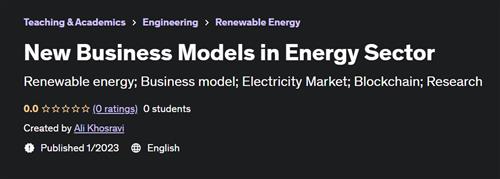
Published 1/2023
Created by Ali Khosravi
MP4 | Video: h264, 1280×720 | Audio: AAC, 44.1 KHz, 2 Ch
Genre: eLearning | Language: English | Duration: 5 Lectures ( 1h 10m ) | Size: 469 MB
Renewable energy; Business model; Electricity Market; Blockchain; Research
What you’ll learn
Aggregators
Peer-to-peer electricity trading based on blockchain technology
Energy-as-a-service
Community-ownership models
Pay-as-you-go models
Requirements
You’ll have all the information you need.
Description
Information and communication technologies (ICTs), power electronics, and distributed energy resources (such as gas-fired distributed generation, solar PV, small wind farms, electric vehicles, energy storage, and demand response) are all currently having a significant impact on the way that electricity systems operate. Contrary to "conventional" centralized generating units, distributed energy sources (DERs) are connected to low- and medium-voltage power distribution systems and have limited capacity. These technologies have the potential to provide novel services made possible by their distributed nature in addition to the valued electrical services that have historically been provided by centralized producing units. You will learn about the innovative business models in the energy sector that are being used to boost the proportion of renewable energy sources.1. Aggregators: A number of DERs can be operated by an aggregator to provide a sizable capacity that is comparable to that of a traditional generator.2. Peer-to-Peer electricity trading based on blockchain technology: Peer-to-peer (P2P) power trading is a business model built on a network of interconnected platforms that acts as an online marketplace where producers and consumers may "meet" and conduct direct electricity trades without the need of a middleman.3. Energy-as-a-service: A new business model known as "energy as a service" (EaaS) allows service providers to offer a variety of energy-related services in addition to electricity.4. Community-ownership models: Community-ownership structures refer to the collective ownership and control of energy-related assets, often distributed energy resources, in the context of the global energy transition and the decentralization of power networks (DERs).5. Pay-as-you-go models: The PAYG business model is an innovation that was developed to solve the issue of energy access and to offer power produced from renewable energy sources at competitive costs, with payments made possible by technology present in these regions.
Who this course is for
Suitable for anybody interested in energy sector
Homepage
www.udemy.com/course/new-business-models-in-energy-sector/
Buy Premium From My Links To Get Resumable Support,Max Speed & Support Me
Fikper
vzgsn.New.Business.Models.in.Energy.Sector.rar.html
Rapidgator
vzgsn.New.Business.Models.in.Energy.Sector.rar.html
Uploadgig
vzgsn.New.Business.Models.in.Energy.Sector.rar
NitroFlare
vzgsn.New.Business.Models.in.Energy.Sector.rar
Links are Interchangeable – No Password – Single Extraction










Leave a Reply
You must be logged in to post a comment.